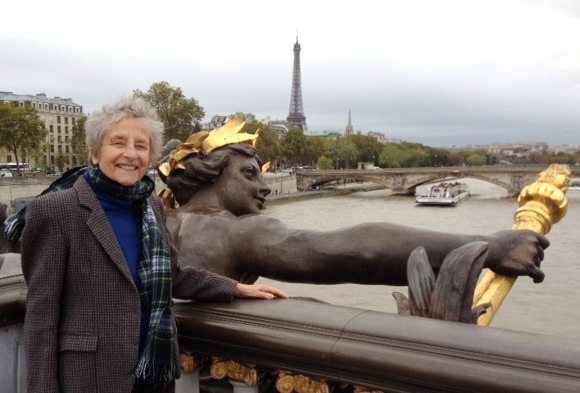
One could describe the exhibit as intimate. Only 80 paintings hang in the small rooms of the Musée du Luxembourg, some of them never seen before. The style is familiar. the colors are soft, the scenes are peaceful — we are in the Impressionists’ world to meet old friends: Monet, Manet, Degas, Sisley, Pissarro, Eugene Boudin, Renoir, Berthe Morisot, Mary Cassatt.
 The title of the exhibit is, “Paul Durand-Ruel. The Impressionist Gamble – Manet, Monet, Renoir,” and it tells the endearing story of the first art dealer in history … and also one of the most influential.
The title of the exhibit is, “Paul Durand-Ruel. The Impressionist Gamble – Manet, Monet, Renoir,” and it tells the endearing story of the first art dealer in history … and also one of the most influential.
The artwork is stunning: in “Le Pont à Villeneuve -la-Garenne,” Sisley creates the fluidity of the water by using multicolor brush strokes and in Renoir’s dance scenes, 1883, couples twirl around happily, women’s eyes bright, their ruffled dresses contrasting with the dark suits of their older escorts. “Liseuse” by Monet shows a young woman sitting on the grass, enveloped by vegetation, spots of light dots her pink dress and in “Le Foyer de la Dance,” Degas’ dancers warm up, others are stretching, while, in the foreground, a little old lady, slouching in a chair is reading a newspaper. Nearby another painting is identical, except for the empty chair — the little old lady is gone.
The story behind the artwork is equally fascinating. Durand-Ruel (1831-1922) became an art dealer by accident. Attracted to a military career, he entered Saint Cyr (equivalent of West Point) but renounced for medical reasons. He was struck by the paintings of Eugene Delacroix exhibited at the 1855 Exposition Universelle (World’s Fair). He became fascinated by the artists who were refused access to the official Salon of the Academy of Fine Arts because of their innovative techniques.
In 1871, Paul met Monet and Pissarro in London where they had taken refuge from the Franco-Prussian war. After his return to Paris, he visited Manet in his studio, liked his work so much that he bought 23 of his paintings at one go. The Luxembourg exhibit includes two of Manet ‘s major works: “Clair de Lune at Boulogne” and “Le Combat du Kearsage et de l’Alabama”.
Left alone after the his wife’s death, he turned his art dealership into a family business with his five children. He opened galleries in London, Brussels, New York and later, Berlin.
In 1874, a group of young artists – who were given, at that time, the collective term of ‘Impressionists’ – showed their work for the first time together in the studio of photographer Nadar.
Durand-Ruel fought to help the artists, both morally and financially, and became their friend. He borrowed money to purchase their paintings. He offered his living room on Rue de Rome to a penniless Monet and lent him money to move to Giverny. Years later, when he was rich and famous, Monet wrote, “We would have starved to death without Paul. ”
In 1886, the American Art Association invited him to organize an exhibit in New York. It was a success and became the first official recognition of the Impressionists.
One cannot help compare the story of such a life to the speculation around art today and to the giant art fairs (like Art Basel) when intermediaries are commissioned by owners with deep pockets.
The exhibition at the Musée de Luxembourg continues through Feb. 8, 2015.

About the author: Nicole Prévost Logan divides her time between Essex and Paris, spending summers in the former and winters in the latter. She writes a regular column for us from her Paris home where her topics will include politics, economy, social unrest — mostly in France — but also in other European countries. She also covers a variety of art exhibits and the performing arts in Europe. Logan is the author of ‘Forever on the Road: A Franco-American Family’s Thirty Years in the Foreign Service,’ an autobiography of her life as the wife of an overseas diplomat, who lived in 10 foreign countries on three continents. Her experiences during her foreign service life included being in Lebanon when civil war erupted, excavating a medieval city in Moscow and spending a week under house arrest in Guinea.